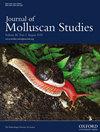Living in solitude or building reefs: ecophenotypic variation of the vermetid Petaloconchus varians revealed by mitochondrial DNA analysis
IF 1.2
4区 生物学
Q2 MARINE & FRESHWATER BIOLOGY
引用次数: 1
Abstract
This study aimed to investigate whether the marine snails Petaloconchus varians (d'Orbigny, 1839) and Petaloconchus myrakeenae Absalão & Rios, 1987 from southeastern Brazil are conspecific. Both species were described from Rio de Janeiro, and they diverge mainly in their growth forms (i.e. gregarious for P. varians and solitary for P. myrakeenae). Examination of shell features, operculum, radula and anatomic details revealed no differences between the species. Analysis of partial cytochrome c oxidase subunits I (CO1) sequences showed that all Petaloconchus samples from Rio de Janeiro clustered into a single clade, which included specimens from the Caribbean (Venezuela). In addition, a genetic differentiation test showed that the analysed populations are structured and the species likely originated in the Caribbean and has undergone significant population expansion. We conclude that P. myrakeenae is a junior synonym of P. varians and provide a morphological redescription of the latter. Furthermore, we argue that different growth forms of P. varians are ecophenotypes, apparently influenced by wave action and water temperature. Tests should be conducted to confirm this hypothesis and to evaluate the impact of other parameters on the plasticity of growth forms, such as food supply and habitat heterogeneity.生活在孤独或建造珊瑚礁中:线粒体DNA分析揭示的变异花瓣珊瑚的生态表型变异
本研究旨在调查巴西东南部的Petalocconchus varians(d’Orbigny,1839)和Petalonconchus myrakeenae Absalão&Rios,1987是否为同种。这两个物种都来自里约热内卢,它们主要在生长形式上存在差异(即变种P.varians为群居物种,myrakeenae为独居物种)。对外壳特征、盖、瓣和解剖细节的检查显示,不同物种之间没有差异。对部分细胞色素c氧化酶亚基I(CO1)序列的分析表明,来自里约热内卢的所有花瓣角珊瑚样本都聚集在一个单一的分支中,其中包括来自加勒比海(委内瑞拉)的样本。此外,一项基因分化测试表明,所分析的种群是结构化的,该物种可能起源于加勒比地区,并经历了显著的种群扩张。我们得出结论,P.myrakeenae是P.varians的初级同义词,并对后者进行了形态学上的重新描述。此外,我们认为不同生长形式的变种P.varians是生态表型,明显受到波浪作用和水温的影响。应进行测试以证实这一假设,并评估其他参数对生长形式可塑性的影响,如食物供应和栖息地异质性。
本文章由计算机程序翻译,如有差异,请以英文原文为准。
求助全文
约1分钟内获得全文
求助全文
来源期刊

Journal of Molluscan Studies
生物-动物学
CiteScore
3.00
自引率
8.30%
发文量
36
审稿时长
3 months
期刊介绍:
The Journal of Molluscan Studies accepts papers on all aspects of the study of molluscs. These include systematics, molecular genetics, palaeontology, ecology, evolution, and physiology. Where the topic is in a specialized field (e.g. parasitology, neurobiology, biochemistry, molecular biology), submissions will still be accepted as long as the mollusc is the principal focus of the study, and not incidental or simply a convenient experimental animal. Papers with a focus on fisheries biology, aquaculture, and control of molluscan pests will be accepted only if they include significant advances in molluscan biology. While systematic papers are encouraged, descriptions of single new taxa will only be considered if they include some ‘added value’, for example in the form of new information on anatomy or distribution, or if they are presented in the context of a systematic revision or phylogenetic analysis of the group.
 求助内容:
求助内容: 应助结果提醒方式:
应助结果提醒方式:


